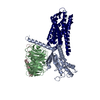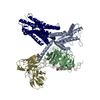[English] 日本語
 Yorodumi
Yorodumi- PDB-7xna: Crystal structure of somatostatin receptor 2 (SSTR2) with peptide... -
+ Open data
Open data
- Basic information
Basic information
| Entry | Database: PDB / ID: 7xna | |||||||||||||||||||||||||||
|---|---|---|---|---|---|---|---|---|---|---|---|---|---|---|---|---|---|---|---|---|---|---|---|---|---|---|---|---|
| Title | Crystal structure of somatostatin receptor 2 (SSTR2) with peptide antagonist CYN 154806 | |||||||||||||||||||||||||||
 Components Components |
| |||||||||||||||||||||||||||
 Keywords Keywords |  SIGNALING PROTEIN/INHIBITOR / SIGNALING PROTEIN/INHIBITOR /  G protein-coupled receptor / G protein-coupled receptor /  somatostatin receptor 2 / somatostatin receptor 2 /  STRUCTURAL PROTEIN / STRUCTURAL PROTEIN /  SIGNALING PROTEIN / SIGNALING PROTEIN /  SIGNALING PROTEIN-INHIBITOR complex SIGNALING PROTEIN-INHIBITOR complex | |||||||||||||||||||||||||||
| Function / homology |  Function and homology information Function and homology information somatostatin receptor activity / somatostatin receptor activity /  peristalsis / peristalsis /  neuropeptide binding / cellular response to glucocorticoid stimulus / neuropeptide binding / cellular response to glucocorticoid stimulus /  endo-1,4-beta-xylanase activity / endo-1,4-beta-xylanase activity /  endo-1,4-beta-xylanase / response to starvation / xylan catabolic process / G protein-coupled receptor signaling pathway, coupled to cyclic nucleotide second messenger / neuropeptide signaling pathway ... endo-1,4-beta-xylanase / response to starvation / xylan catabolic process / G protein-coupled receptor signaling pathway, coupled to cyclic nucleotide second messenger / neuropeptide signaling pathway ... somatostatin receptor activity / somatostatin receptor activity /  peristalsis / peristalsis /  neuropeptide binding / cellular response to glucocorticoid stimulus / neuropeptide binding / cellular response to glucocorticoid stimulus /  endo-1,4-beta-xylanase activity / endo-1,4-beta-xylanase activity /  endo-1,4-beta-xylanase / response to starvation / xylan catabolic process / G protein-coupled receptor signaling pathway, coupled to cyclic nucleotide second messenger / neuropeptide signaling pathway / forebrain development / adenylate cyclase-inhibiting G protein-coupled receptor signaling pathway / Peptide ligand-binding receptors / cerebellum development / cellular response to estradiol stimulus / endo-1,4-beta-xylanase / response to starvation / xylan catabolic process / G protein-coupled receptor signaling pathway, coupled to cyclic nucleotide second messenger / neuropeptide signaling pathway / forebrain development / adenylate cyclase-inhibiting G protein-coupled receptor signaling pathway / Peptide ligand-binding receptors / cerebellum development / cellular response to estradiol stimulus /  PDZ domain binding / G alpha (i) signalling events / PDZ domain binding / G alpha (i) signalling events /  spermatogenesis / neuron projection / negative regulation of cell population proliferation / spermatogenesis / neuron projection / negative regulation of cell population proliferation /  plasma membrane / plasma membrane /  cytosol cytosolSimilarity search - Function | |||||||||||||||||||||||||||
| Biological species |   Homo sapiens (human) Homo sapiens (human) Niallia circulans (bacteria) Niallia circulans (bacteria)synthetic construct (others) | |||||||||||||||||||||||||||
| Method |  X-RAY DIFFRACTION / X-RAY DIFFRACTION /  SYNCHROTRON / SYNCHROTRON /  MOLECULAR REPLACEMENT / Resolution: 2.65 Å MOLECULAR REPLACEMENT / Resolution: 2.65 Å | |||||||||||||||||||||||||||
 Authors Authors | Zhao, W. / Han, S. / Qiu, N. / Feng, W. / Lu, M. / Yang, D. / Wang, M.-W. / Wu, B. / Zhao, Q. | |||||||||||||||||||||||||||
| Funding support |  China, 8items China, 8items
| |||||||||||||||||||||||||||
 Citation Citation |  Journal: Cell Res / Year: 2022 Journal: Cell Res / Year: 2022Title: Structural insights into ligand recognition and selectivity of somatostatin receptors. Authors: Wenli Zhao / Shuo Han / Na Qiu / Wenbo Feng / Mengjie Lu / Wenru Zhang / Mu Wang / Qingtong Zhou / Shutian Chen / Wei Xu / Juan Du / Xiaojing Chu / Cuiying Yi / Antao Dai / Liaoyuan Hu / ...Authors: Wenli Zhao / Shuo Han / Na Qiu / Wenbo Feng / Mengjie Lu / Wenru Zhang / Mu Wang / Qingtong Zhou / Shutian Chen / Wei Xu / Juan Du / Xiaojing Chu / Cuiying Yi / Antao Dai / Liaoyuan Hu / Michelle Y Shen / Yaping Sun / Qing Zhang / Yingli Ma / Wenge Zhong / Dehua Yang / Ming-Wei Wang / Beili Wu / Qiang Zhao /  Abstract: Somatostatin receptors (SSTRs) play versatile roles in inhibiting the secretion of multiple hormones such as growth hormone and thyroid-stimulating hormone, and thus are considered as targets for ...Somatostatin receptors (SSTRs) play versatile roles in inhibiting the secretion of multiple hormones such as growth hormone and thyroid-stimulating hormone, and thus are considered as targets for treating multiple tumors. Despite great progress made in therapeutic development against this diverse receptor family, drugs that target SSTRs still show limited efficacy with preferential binding affinity and conspicuous side-effects. Here, we report five structures of SSTR2 and SSTR4 in different states, including two crystal structures of SSTR2 in complex with a selective peptide antagonist and a non-peptide agonist, respectively, a cryo-electron microscopy (cryo-EM) structure of G-bound SSTR2 in the presence of the endogenous ligand SST-14, as well as two cryo-EM structures of G-bound SSTR4 in complex with SST-14 and a small-molecule agonist J-2156, respectively. By comparison of the SSTR structures in different states, molecular mechanisms of agonism and antagonism were illustrated. Together with computational and functional analyses, the key determinants responsible for ligand recognition and selectivity of different SSTR subtypes and multiform binding modes of peptide and non-peptide ligands were identified. Insights gained in this study will help uncover ligand selectivity of various SSTRs and accelerate the development of new molecules with better efficacy by targeting SSTRs. | |||||||||||||||||||||||||||
| History |
|
- Structure visualization
Structure visualization
| Structure viewer | Molecule:  Molmil Molmil Jmol/JSmol Jmol/JSmol |
|---|
- Downloads & links
Downloads & links
- Download
Download
| PDBx/mmCIF format |  7xna.cif.gz 7xna.cif.gz | 116.1 KB | Display |  PDBx/mmCIF format PDBx/mmCIF format |
|---|---|---|---|---|
| PDB format |  pdb7xna.ent.gz pdb7xna.ent.gz | 82.8 KB | Display |  PDB format PDB format |
| PDBx/mmJSON format |  7xna.json.gz 7xna.json.gz | Tree view |  PDBx/mmJSON format PDBx/mmJSON format | |
| Others |  Other downloads Other downloads |
-Validation report
| Arichive directory |  https://data.pdbj.org/pub/pdb/validation_reports/xn/7xna https://data.pdbj.org/pub/pdb/validation_reports/xn/7xna ftp://data.pdbj.org/pub/pdb/validation_reports/xn/7xna ftp://data.pdbj.org/pub/pdb/validation_reports/xn/7xna | HTTPS FTP |
|---|
-Related structure data
| Related structure data |  7xmrC  7xmsC  7xmtC  7xn9C  2b45S  4n6hS S: Starting model for refinement C: citing same article ( |
|---|---|
| Similar structure data | Similarity search - Function & homology  F&H Search F&H Search |
- Links
Links
- Assembly
Assembly
| Deposited unit | 
| ||||||||||||
|---|---|---|---|---|---|---|---|---|---|---|---|---|---|
| 1 |
| ||||||||||||
| Unit cell |
|
- Components
Components
| #1: Protein | Mass: 65500.605 Da / Num. of mol.: 1 Source method: isolated from a genetically manipulated source Details: fusion protein of SSTR2 and Endo-1,4-beta-xylanase Source: (gene. exp.)   Homo sapiens (human), (gene. exp.) Homo sapiens (human), (gene. exp.)  Niallia circulans (bacteria) Niallia circulans (bacteria)Gene: SSTR2, xlnA / Production host:  Insecta environmental sample (insect) Insecta environmental sample (insect)References: UniProt: P30874, UniProt: P09850,  endo-1,4-beta-xylanase endo-1,4-beta-xylanase |
|---|---|
| #2: Protein/peptide | Mass: 1183.359 Da / Num. of mol.: 1 / Source method: obtained synthetically / Source: (synth.) synthetic construct (others) |
| Has ligand of interest | Y |
-Experimental details
-Experiment
| Experiment | Method:  X-RAY DIFFRACTION / Number of used crystals: 1 X-RAY DIFFRACTION / Number of used crystals: 1 |
|---|
- Sample preparation
Sample preparation
| Crystal | Density Matthews: 2.24 Å3/Da / Density % sol: 45.18 % |
|---|---|
Crystal grow | Temperature: 293 K / Method: lipidic cubic phase / pH: 7 Details: 100-300 mM ammonium sulphate, 6-10% PEG2000, 1 mg/ml CYN 154806, and 0.1 M HEPES, pH 7.0 |
-Data collection
| Diffraction | Mean temperature: 80 K / Serial crystal experiment: N |
|---|---|
| Diffraction source | Source:  SYNCHROTRON / Site: SYNCHROTRON / Site:  SPring-8 SPring-8  / Beamline: BL41XU / Wavelength: 1 Å / Beamline: BL41XU / Wavelength: 1 Å |
| Detector | Type: DECTRIS PILATUS3 6M / Detector: PIXEL / Date: Apr 27, 2016 |
| Radiation | Protocol: SINGLE WAVELENGTH / Monochromatic (M) / Laue (L): M / Scattering type: x-ray |
| Radiation wavelength | Wavelength : 1 Å / Relative weight: 1 : 1 Å / Relative weight: 1 |
| Reflection | Resolution: 2.65→40.82 Å / Num. obs: 17481 / % possible obs: 97.7 % / Redundancy: 3.69 % / Biso Wilson estimate: 58 Å2 / CC1/2: 0.954 / Net I/σ(I): 3.1 |
| Reflection shell | Resolution: 2.65→2.745 Å / Num. unique obs: 1711 / CC1/2: 0.712 |
- Processing
Processing
| Software |
| |||||||||||||||||||||||||||||||||||||||||||||||||||||||||||||||||||||||||||||||||||||||||||
|---|---|---|---|---|---|---|---|---|---|---|---|---|---|---|---|---|---|---|---|---|---|---|---|---|---|---|---|---|---|---|---|---|---|---|---|---|---|---|---|---|---|---|---|---|---|---|---|---|---|---|---|---|---|---|---|---|---|---|---|---|---|---|---|---|---|---|---|---|---|---|---|---|---|---|---|---|---|---|---|---|---|---|---|---|---|---|---|---|---|---|---|---|
| Refinement | Method to determine structure : :  MOLECULAR REPLACEMENT MOLECULAR REPLACEMENTStarting model: 4N6H, 2B45 Resolution: 2.65→40.82 Å / SU ML: 0.352 / Cross valid method: FREE R-VALUE / σ(F): 100 / Phase error: 29.1143 Stereochemistry target values: GeoStd + Monomer Library + CDL v1.2
| |||||||||||||||||||||||||||||||||||||||||||||||||||||||||||||||||||||||||||||||||||||||||||
| Solvent computation | Shrinkage radii: 0.9 Å / VDW probe radii: 1.11 Å / Solvent model: FLAT BULK SOLVENT MODEL | |||||||||||||||||||||||||||||||||||||||||||||||||||||||||||||||||||||||||||||||||||||||||||
| Refinement step | Cycle: LAST / Resolution: 2.65→40.82 Å
| |||||||||||||||||||||||||||||||||||||||||||||||||||||||||||||||||||||||||||||||||||||||||||
| Refine LS restraints |
| |||||||||||||||||||||||||||||||||||||||||||||||||||||||||||||||||||||||||||||||||||||||||||
| LS refinement shell |
|
 Movie
Movie Controller
Controller





 PDBj
PDBj











